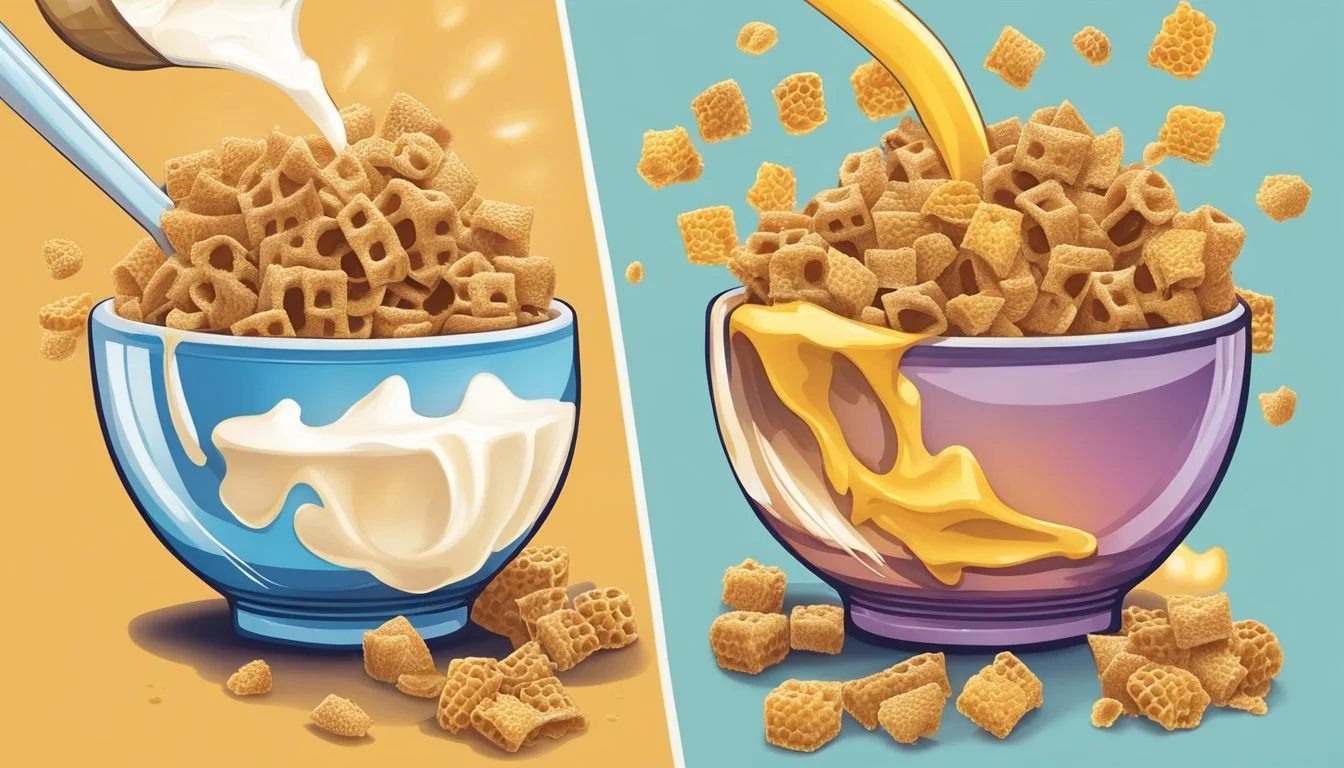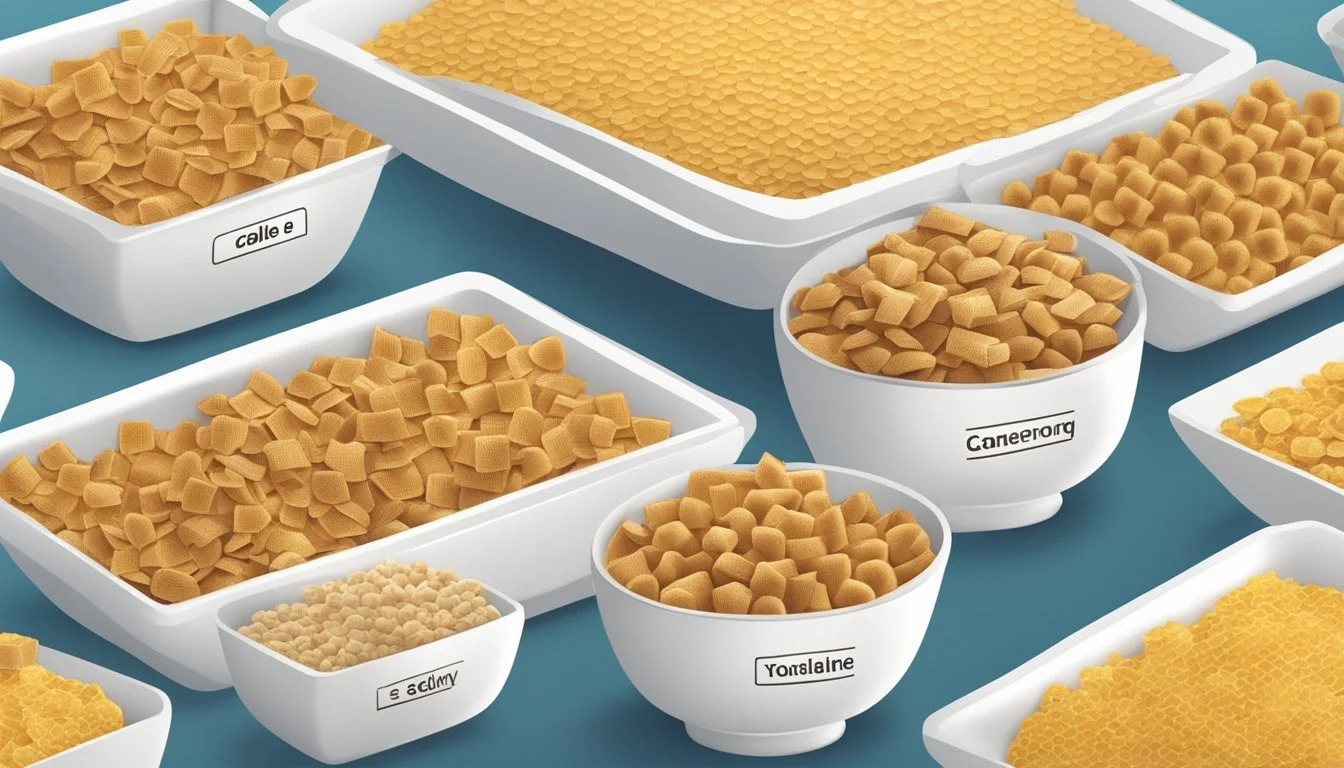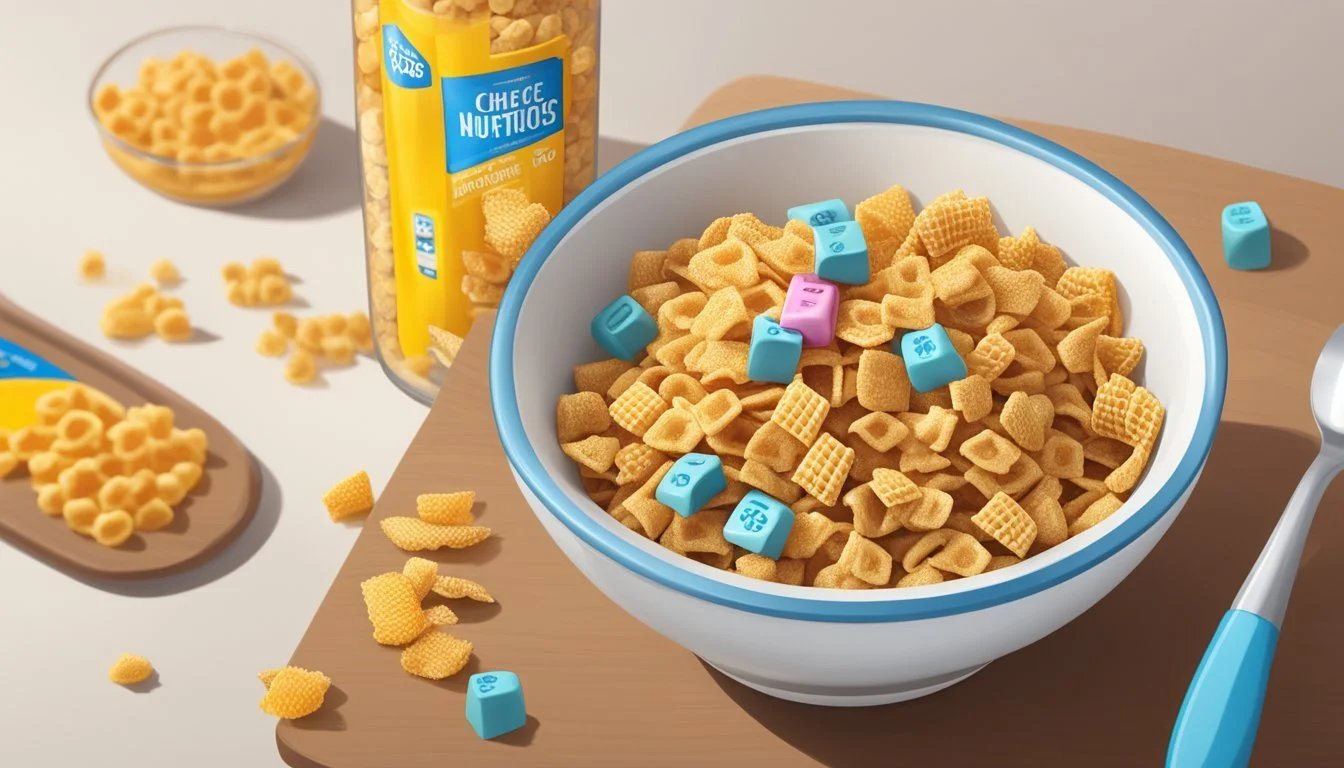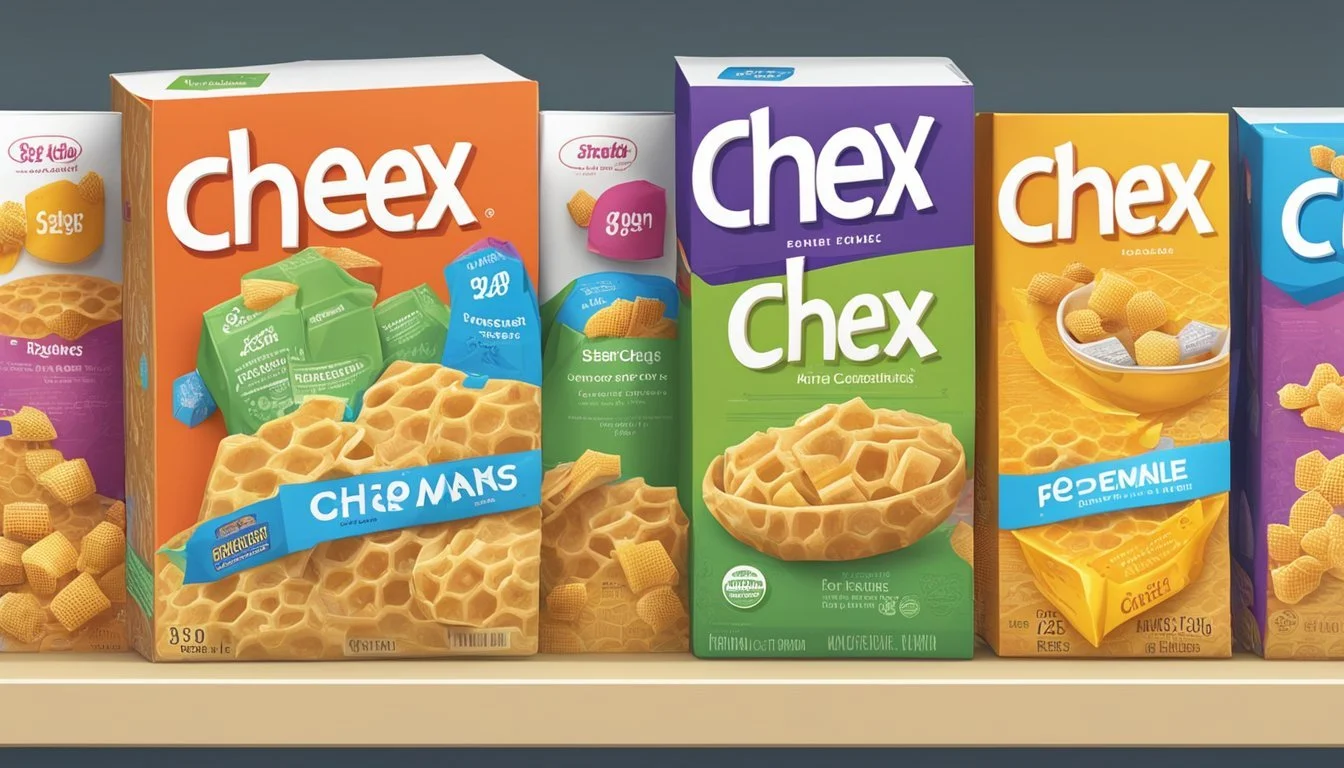Chex vs Honeycomb
A Comparative Breakfast Cereal Analysis
This Article is Part of Our Breakfast Cereal Guide with Details on Chex Nutrition and Honeycomb Nutrition
When it comes to breakfast cereals, both Chex and Honeycomb offer unique qualities that appeal to different tastes and nutritional needs. Chex cereals, known for their variety and whole grain options, often provide a healthier choice for those looking to maintain a balanced diet. On the other hand, Honeycomb, with its sweeter profile, tends to attract those who prefer a more indulgent breakfast experience.
When comparing nutrition, Chex cereals typically have higher fiber content and less sugar, making them a preferable option for health-conscious individuals. For instance, Wheat Chex offers more complex carbohydrates per serving than Honeycomb, which can contribute to sustained energy levels throughout the morning. Honeycomb delivers a nostalgic, sweet flavor that might be less nutritious but more appealing to those with a sweet tooth.
The choice between Chex and Honeycomb may ultimately come down to personal preference and dietary goals. Those prioritizing nutrition might lean towards Chex, while those seeking a comforting, sweet breakfast might find Honeycomb more satisfying. This comparison highlights the diverse options available in the cereal aisle, ensuring there’s something for everyone’s breakfast table.
History and Manufacturers
Chex and Honey-Comb are two iconic cereals with distinct histories and different manufacturers. Understanding their origins provides insight into their market presence and consumer perception.
General Mills and the Chex Brand
Chex, an American breakfast cereal, is currently produced by General Mills. The cereal was first introduced in 1936 by Ralston Purina under the name "Shredded Ralston."
In 1950, the name was changed to Chex, reflecting its distinctive checkerboard shape. In 1994, Chex was spun off to Ralcorp before being acquired by General Mills in 1997. General Mills has since expanded the Chex line to include varieties like Rice Chex, Corn Chex, and Wheat Chex, making it a versatile offering for consumers.
Post and the Honey-Comb Brand
Honey-Comb is another stalwart in the cereal world, produced by Post Consumer Brands. Launched in 1965, this cereal is known for its honey-flavored hexagonal pieces.
Post, a major player in the breakfast cereal industry, has maintained the Honey-Comb brand for decades, updating its formula and packaging to keep pace with consumer preferences. Honey-Comb aims to provide a sweet, crunchy breakfast option, appealing to both children and adults with its distinctive taste and texture.
These brands illustrate how historical development and strategic company decisions shape the cereals enjoyed by millions today.
Nutritional Profiles
Chex and Honeycomb cereals have varying nutritional profiles that can influence dietary choices. This section provides a detailed comparison of calories, serving sizes, macronutrients, fiber, sugars, sweeteners, vitamins, and minerals.
Calories and Serving Sizes
Calories are a key factor in evaluating breakfast cereals. Honey-comb contains 110 calories per serving, while Corn Chex has 120 calories per serving. Wheat Chex has slightly lower calories at 100 per serving.
Both cereals come in standard serving sizes of about one cup. It's essential to note serving sizes to maintain portion control and manage calorie intake effectively, playing a significant role in daily dietary goals.
Macronutrients and Fiber
Macronutrient content is critical for those tracking protein, fats, and carbohydrates. Corn Chex provides 2 grams of protein per serving. Wheat Chex offers a higher protein content with 3 grams per serving. Honey-comb provides just 1 gram of protein per serving.
Fiber is paramount for digestive health. Corn Chex possesses 1 gram of dietary fiber per serving, and Wheat Chex contains 3 grams per serving. Honey-comb lacks significant fiber content, making it a less preferred option for fiber intake.
Sugars and Sweeteners
Sugar content can significantly impact the nutritional value of cereals. Honey-comb contains about 8 grams of sugar per serving. Cinnamon Chex is similar, with 8 grams of sugar per serving. In comparison, Corn Chex only contains 2 grams of sugar per serving.
Those managing sugar intake should be cautious about Honey-comb and Cinnamon Chex due to their higher sugar content. Corn Chex provides a better option for those seeking lower sugar levels.
Vitamins and Minerals
Vitamins and minerals fortification varies between cereals. Cheerios, another popular brand from General Mills, offers 136 milligrams of sodium and various added vitamins. Similarly, Corn Chex and Wheat Chex are fortified with essential vitamins and minerals, though specific percentages vary.
Honey-comb includes basic fortification, but lacks the extensive vitamin and mineral profile found in other options. Fortified cereals often provide essential nutrients such as iron, Vitamin D, and B vitamins, contributing to a balanced diet.
Understanding these factors can help make informed decisions about daily cereal consumption and nutrient intake.
Health Considerations
Chex and Honeycomb cereals impact health differently based on various factors such as calorie content, dietary restrictions, and nutritional benefits. This section explores essential aspects like recommended daily intake, weight management, and dietary restrictions.
Recommended Daily Intake
Calories per Serving: Chex provides approximately 120 calories per serving whereas Honeycomb offers around 100 calories per serving.
Fiber Content: Wheat Chex is higher in fiber due to its whole grain content. This can be important for digestive health and meeting the recommended daily intake of fiber.
Added Sugar: Honeycomb contains more added sugar. Comparing labels, Honeycomb typically has around 12 grams of sugar per serving, while many variants of Chex have lower sugar content making them more suitable for those monitoring their sugar intake.
Weight Management
Healthy Breakfast: Chex, especially whole grain options like Wheat Chex, can be part of a balanced breakfast.
Lower in Sugar: Lower sugar content in Chex can help with managing weight, as excessive sugar intake is linked to weight gain.
Whole Grain: Eating whole grains, present in several Chex variants, can support weight management. Whole grains contribute to feelings of fullness, aiding in appetite control.
Calories per Serving: Being mindful of the caloric intake from cereals like Chex and Honeycomb can contribute to effective weight management. Ensuring that the portion size stays within the recommended serving helps balance daily caloric intake.
Dietary Restrictions
Gluten Free: Corn Chex is a gluten-free option that caters to individuals with celiac disease or gluten sensitivities.
Healthy: Opting for cereals with low added sugar and high fiber content aligns with many dietary guidelines. For those watching their carbohydrate intake, options like Corn Chex offer a moderate amount of complex carbohydrates.
FDA Recommendation: Adhering to the daily FDA recommendations, which suggest limiting added sugars and prioritizing nutrient-dense foods, can guide choices between these cereals.
Chex generally offers more diverse options that can comply with various dietary restrictions compared to Honeycomb, making it a versatile choice for many consumers.
Product Varieties and Flavors
Chex and Honeycomb cereals each offer unique varieties and flavors that cater to different taste preferences and dietary needs. Understanding the variety in each product line helps in choosing the cereal that best suits individual tastes.
Chex Varieties
Chex cereals come in a diverse range of flavors and grains. The Corn Chex variety is popular for its crispy texture and mild taste, making it a staple in many households. Wheat Chex offers a heartier option, rich in whole grains, perfect for those looking for a more robust flavor.
Rice Chex caters to those seeking a lighter, gluten-free option. Honey Nut Chex and Chocolate Chex provide sweeter alternatives, balancing the lineup with flavors that appeal to a broader audience. Additionally, Chex offers a range of Chex Mix recipes, incorporating their cereals into savory snacks like Zesty Taco and spicy Ghost Pepper flavors.
Hive-Shaped Honeycomb
Honeycomb cereal is easily recognizable with its distinctive hexagonal shape and light, airy texture. This classic cereal offers a sweet honey flavor, appealing to both children and adults. While Honeycomb doesn't have the extensive range of flavors that Chex does, it excels with its signature taste.
There are variations like Giant Honeycomb, which features larger pieces, providing a different eating experience. For those who love the honey taste but seek variety, Honey Nut Cheerios or Rice Krispies variants, offer sweet and crunchy alternatives, though not directly from the Honeycomb brand itself.
Consumer Preferences and Ratings
Consumer preferences for Chex and Honeycomb cereals can vary widely based on factors such as taste, texture, and market recognition. Each cereal offers unique qualities that appeal to different segments of consumers.
Taste Profile Comparison
Chex cereals, particularly Wheat Chex and Corn Chex, are noted for their mild and neutral taste, making them versatile for a variety of recipes. They are less sweet compared to other cereals, making them a preferred choice for those looking to avoid excessive sugar.
In contrast, Honeycomb cereal has a distinct honey flavor which stands out to consumers who prefer a sweeter and more robust taste in their breakfast. Honey Nut Cheerios also attracts a similar demographic with its sweet, nutty flavor but remains a competition due to its balanced taste that includes a hint of oats.
Raisin Bran and Frosted Flakes are also popular among sweet cereal enthusiasts, adding another layer of comparability when discussing taste preferences.
Texture and Consistency
The texture of Chex cereals is often described as crispy and light. Their square-shaped pieces hold up well in milk, providing a consistent crunch that many consumers find satisfying. This texture also makes Chex a staple in snack mixes and recipes.
Honeycomb, on the other hand, offers a larger, hexagonal shape with a somewhat airy and melt-in-the-mouth consistency. It tends to become soggy faster in milk compared to Chex but retains its unique texture longer during dry consumption.
Frosted Flakes maintain a similar crunch to Chex initially but tend to soften quickly in milk, aligning more with Honeycomb's texture profile over time. Raisin Bran offers a mix of textures, combining crunchy bran flakes with softer raisins, catering to diverse texture preferences.
Market Recognition and Popularity
Chex cereals have a solid market presence, largely due to their versatility and the ability to cater to both savory and sweet tastes. Products like Chex Mix have reinforced their popularity beyond just a breakfast option.
Honeycomb, while not as versatile, has a loyal following because of its nostalgic value and distinctive flavor. It is often associated with a unique childhood experience, driving its continued demand despite a smaller range of product variations.
Both are well-regarded in the cereal market, but Honey Nut Cheerios often ranks higher in consumer ratings due to a strong brand image and consistent taste profile. Frosted Flakes enjoys high recognition and is often rated favorably for its sweetness and nostalgic appeal.
Alternative Uses and Recipes
Both Chex and Honeycomb cereals offer a variety of uses beyond the traditional bowl of breakfast cereal. These versatile ingredients can be transformed into a multitude of creative snacks and dishes that are perfect for any occasion.
Cereal Beyond Breakfast
Chex and Honeycomb aren't just for breakfast; they can play a starring role in many snacks and desserts. From homemade cereal bars to party mixes, these cereals add crunch and flavor.
Chex is often used in Chex Mix, a popular snack that can be sweet, savory, or spicy, featuring combinations of pretzels, nuts, and other mix-ins. Honeycomb, with its larger, honey-flavored puffs, can be used in marshmallow clusters or no-bake treats.
Creative Recipes with Chex and Honeycomb
Recipes using Chex and Honeycomb go beyond the expected. For example:
Chex Cookies: Chex adds a delightful crunch to your average cookie dough.
Honeycomb Krispie Treats: Swap out Rice Krispies for Honeycomb to make a honey-flavored twist on a classic.
Chex Party Mix Variations: There are many variations such as the Furikake Chex Mix which blends sweet and salty flavors using Asian-inspired seasonings.
Each recipe brings a unique twist, making these cereals ideal kitchen staples for inventive cooks.
Comparative Shopping Guide
This guide highlights the key differences in price, availability, distribution, packaging, and sustainability between Corn Chex and Honeycomb cereals to assist shoppers in making an informed decision.
Price Points
Corn Chex and Honeycomb are manufactured by General Mills and Post Consumer Brands respectively. The price can vary based on store location, promotions, and package sizes.
Average prices for both cereals fluctuate between $3 to $4 per box for a 12-ounce box. Generic versions might be available at a lower price point, offering a more budget-friendly option without compromising on taste.
Comparative shopping apps and websites such as Shopzilla and QR Reader can help consumers find the best deals and compare prices across multiple retailers for these cereals.
Availability and Distribution
Both Corn Chex and Honeycomb cereals have widespread distribution across the United States.
Corn Chex is commonly found in major grocery chains, online retailers, and sometimes in smaller local stores. Honeycomb enjoys similar distribution channels.
Some stores might stock more limited quantities of one over the other, which can influence availability. Checking inventory through store websites or contacting local stores directly can provide current stock information to ensure availability before making a trip.
Packaging and Sustainability
Packaging practices of General Mills for Corn Chex and Post Consumer Brands for Honeycomb have come under scrutiny in recent years.
Corn Chex uses a traditional cardboard box with a plastic liner to keep the cereal fresh. General Mills has made efforts to make their packaging more sustainable by using recyclable materials.
Honeycomb also utilizes a similar packaging approach. Post Consumer Brands have committed to improving their environmental footprint, targeting reductions in packaging waste and increasing recyclability.
Consumers looking for more sustainable options might favor cereals with clearly labeled recycling instructions or opt for bulk purchasing to minimize packaging waste.
This guide aims to provide the essential points needed for a smart purchasing decision when comparing Corn Chex and Honeycomb cereals in 2024.









